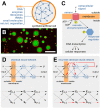Recurrent neural networks in synthetic cells: a route to autonomous molecular agents?
- PMID: 37351468
- PMCID: PMC10284608
- DOI: 10.3389/fbioe.2023.1210334
Recurrent neural networks in synthetic cells: a route to autonomous molecular agents?
Keywords: artificial cells; autonomy; recurrent chemical neural networks; synthetic biology; synthetic cells.
Conflict of interest statement
The authors declare that the research was conducted in the absence of any commercial or financial relationships that could be construed as a potential conflict of interest.
Figures

References
-
- Akyildiz I. F., Pierobon M., Balasubramaniam S., Koucheryavy Y. (2015). The internet of Bio-Nano things. IEEE Commun. Mag. 53, 32–40. 10.1109/MCOM.2015.7060516 - DOI
-
- Altamura E., Albanese P., Marotta R., Milano F., Fiore M., Trotta M., et al. (2021). Chromatophores efficiently promote light-driven ATP synthesis and DNA transcription inside hybrid multicompartment artificial cells. Proc. Natl. Acad. Sci. U. S. A. 118, e2012170118. 10.1073/pnas.2012170118 - DOI - PMC - PubMed
LinkOut - more resources
Full Text Sources

